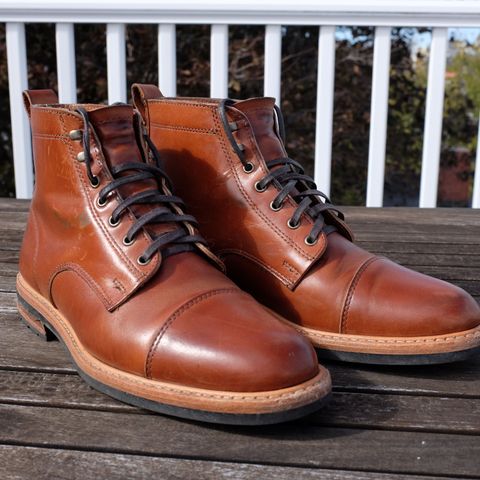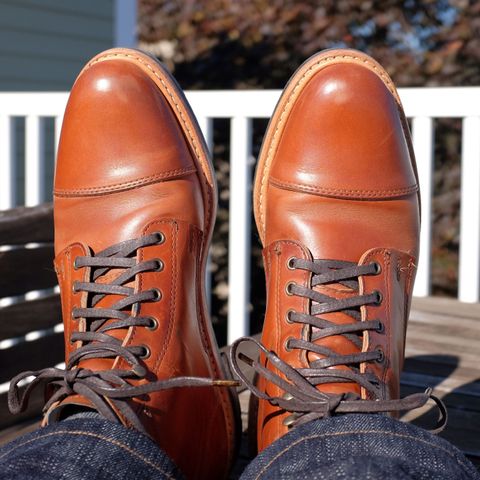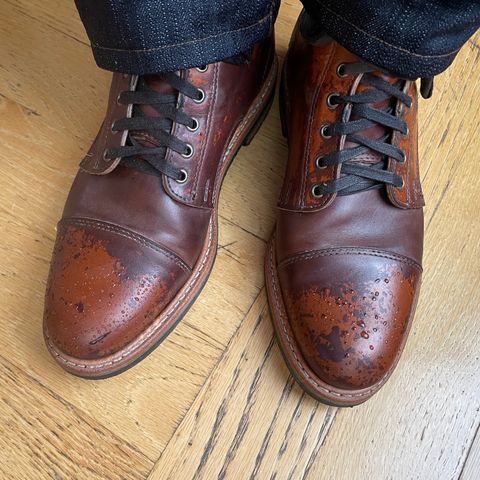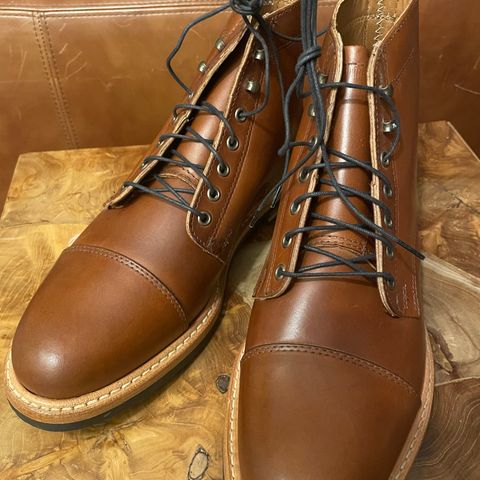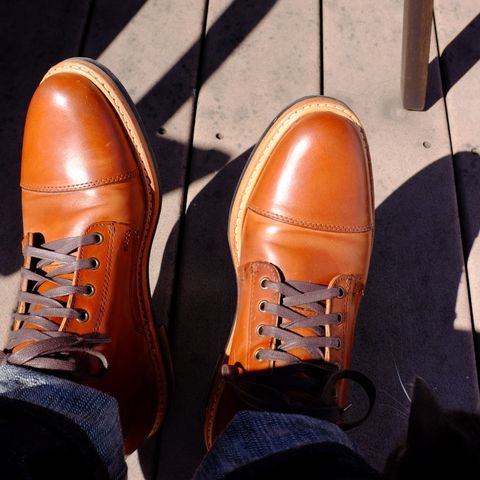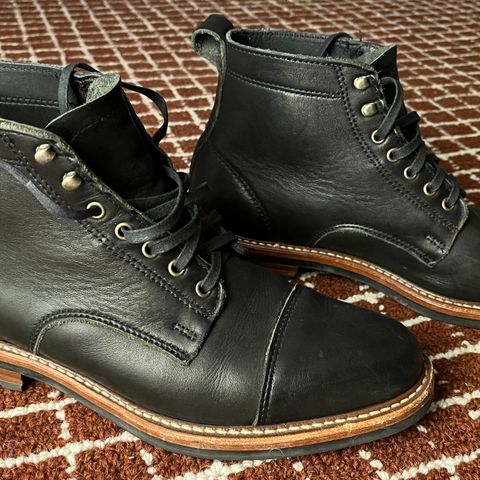About
The Byron Boot is a motorcycle-inspired boot handcrafted by Rancourt & Co. in Lewiston, Maine. Designed with a blend of motorcycle culture aesthetics and sophisticated construction, the Byron Boot represents the company's commitment to traditional American shoemaking while offering versatility for both casual and slightly formal occasions. The boot is constructed using Blake welt stitching and features a leather midsole with storm welt and Vibram #430 mini lug sole.
About
The Byron Boot is a motorcycle-inspired boot handcrafted by Rancourt & Co. in Lewiston, Maine. Designed with a blend of motorcycle culture aesthetics and sophisticated construction, the Byron Boot represents the company's commitment to traditional American shoemaking while offering versatility for both casual and slightly formal occasions. The boot is constructed using Blake welt stitching and features a leather midsole with storm welt and Vibram #430 mini lug sole.
Built on Rancourt's proprietary 115 last, the same foundation used for their dress shoes, the Byron Boot maintains an elegant shape while providing superior fit across a wide range of sizes and widths. The boot is available in multiple premium leather options, including Heritage Brown vegetable-tanned leather, Natural veg tan, Black full grain leather, Horween's hand-burnished Bulldog cowhide, and C.F. Stead's Waxy Commander suede. Each pair is fully lined with soft leather that provides structure and durability without compromising comfort.
Design and Construction
The Byron Boot employs Blake welt stitch construction, a manufacturing method invented by American Lyman Reed Blake in 1856. This construction technique features a single row of stitching inside the upper that attaches the outsole directly to the insole using a chain stitch. The Blake construction method was revolutionary during the Industrial Revolution, as the primary stitch goes straight through the insole, making it impossible to execute by hand and requiring specialized machinery.
The boot is built on Rancourt's proprietary 115 last, which the company also uses for their dress shoe collection. This last provides what the company describes as a "superior fit and elegant shape" while accommodating a wide range of sizes and widths. The design philosophy positions the 115 last as "perfectly straddling the line between dress and casual" footwear applications.
The sole construction combines traditional and modern elements, featuring a leather midsole paired with a storm welt and Vibram #430 mini lug outsole. This combination provides what Rancourt describes as a "winning combination" that delivers the rugged aesthetic without overdoing the "commando" style appearance. The storm welt construction adds weather resistance while maintaining the boot's sophisticated profile.
Materials and Specifications
The Byron Boot is manufactured using several premium leather options, each offering distinct characteristics for different preferences and applications. The Heritage Brown option utilizes vegetable-tanned leather, while the Natural version also employs veg tan leather in an undyed finish. The Black option features full grain leather, providing durability and a formal appearance suitable for dressier occasions.
For specialized applications, the boot is available in Horween's Bulldog leather, described as a hand-burnished cowhide that develops character with wear. The Driftwood option features C.F. Stead's Waxy Commander suede, which the manufacturer characterizes as "rugged low maintenance, weather resistant, durable leather" suitable for challenging conditions.
Each Byron Boot is fully lined throughout the interior. The standard lining consists of soft and supple leather that provides additional structure and durability to the uppers while maintaining comfort during extended wear. Specific models feature Casco horsehide lining in black for the black leather version, while other variants may include tan cowhide lining depending on the exterior leather selection.
Manufacturing Heritage
All Byron Boots are handcrafted in Rancourt & Co.'s factory in Lewiston, Maine, continuing a tradition of American shoemaking that the Rancourt family has maintained since 1967. The company's commitment to domestic manufacturing has persisted even as many competitors have moved production offshore, with Lewiston serving as the exclusive production facility for all Rancourt footwear.
The Blake construction method used in the Byron Boot traces its origins to 1856 when Lyman Reed Blake, then only 23 years old, received a patent for a machine capable of sewing together the insole, uppers, and outsoles of shoes. Blake sold his patent to Gordon McKay in 1859 for $8,000 in cash and $62,000 in future profits. The invention proved particularly significant during the American Civil War in 1861, when increased demand for footwear and a shortage of skilled cobblers called to military service created ideal conditions for mechanized production.
The Blake construction method gained particular popularity in Italy, where it became favored for creating neat, lightweight shoes well-suited to warm, dry climates. This European adoption helped establish Blake construction as a preferred method for elegant footwear that prioritizes flexibility and lighter weight compared to the sturdier Goodyear welt construction more commonly used by British shoemakers.
Availability and Pricing
The Byron Boot is available through Rancourt & Co.'s direct sales channels at a retail price of $478.00 across all leather options. The boot represents the company's positioning in the heritage footwear market, offering handmade American construction with premium materials at a price point that reflects traditional craftsmanship methods and domestic manufacturing costs.
The multiple leather options allow customers to select variants appropriate for different usage scenarios and aesthetic preferences. The Heritage Brown and Natural veg tan options develop patina over time, appealing to heritage footwear enthusiasts who appreciate the aging characteristics of vegetable-tanned leather. The Black full grain option provides versatility for both casual and business casual applications, while the Horween Bulldog and C.F. Stead Waxy Commander options cater to customers seeking specialized leather characteristics or enhanced weather resistance.
References
"Byron Boot - Carolina Brown Chromexcel". Rancourt & Co. Retrieved September 18, 2025.
"History: The Blake Construction". Shoegazing. January 16, 2022.
"Blake Stitch". Santos Shoes. Retrieved September 18, 2025.
"Rancourt Heritage Brand". InsideHook. Retrieved September 18, 2025.
"Rancourt and Company: Made in Maine". Tread Magazine. Retrieved September 18, 2025.
"Strikes, Timbs, and Space Moccasins: A Lewiston-Auburn Shoemaking Timeline". Down East Magazine. Retrieved September 18, 2025.
